For previous chapters click here
The Serengeti
East Africa is, as far as I’m concerned, the most wonderful place on earth. It’s chaotic, absurd, beautiful, deeply corrupt, friendly and dangerous, and too often the subject of myths told by romantic Westerners. But these remain good for the economy, and a whole industry has grown up propagating them, these great untruths.
The Loch Ness monster is a myth sold to foreigners – and a fair few natives – to continue propping up the economy of a relatively remote part of the Scottish Highlands. It works brilliantly. The myth of East Africa is no different, just on a far bigger scale.
From the start of your safari to its end, you’re lost in a Truman Show – a perfectly scripted and executed version of your dream. Your aim is to experience your dream so absolutely that you can fill your soul with it and share it with everyone when you get home, or fuck it, why not this very second on Instagram from the dug-out toilet in your tent. You’ve bought along your his and her beige safari clothes and those trainer-shoe boot things. You’ve got those wide-brimmed hats they have in Africa (if you’re white and on TV) and you’ve strung a Leatherman through your belt loop in case your car breaks down and you’re forced to pitch camp in the perilous bush.
Your safari driver loves you – you share a special connection that transcends the tip he’s expecting, and you know this because you loved your last safari so much that you came back three years later and of course he remembered you. You spend your days cramped in the back of a Toyota minibus or a decked-out Land Cruiser, sipping G&Ts at sundown and telling your driver hilarious tales of your life back home, which he laps up with the exuberant faux interest of a teenage boy trying to get laid. Your safari company has made everything khaki and beige for you, and your italicised menu is written in Karen Blixen’s own hand.
At dinner you spend your time trying to outcompete the other guests with stories of leopards and lions behaving in extraordinary ways that not even your driver has witnessed before. Later on, around the fire and wasted on your sixth G&T, the kitchen staff, all decked out as Maasai warriors, come leaping and chanting from the reception area, imposing a cultural experience on you that will last many long dinner parties back in Atlanta, before they break out into a song from The Lion King. You applaud them all the way back to the kitchens, and they smile and wave in that way that Africans do, then go and clean the slop off your plates. The next morning you get up and do it all over again.
It’s easy to be cynical about it all, of course, and it’s actually kind of fun spotting people with your binoculars wearing pith helmets (yes, they actually still do). But without this dream, and all the people willing to spend small fortunes to experience it, the Maasai Mara would be nothing more than a massive cattle farm. It’s the dream that keeps the myth alive.
An article on the Serengeti, or more accurately ‘The Mara/Serengeti Ecosystem’, was commissioned by National Geographic for no other reason than I went and sat in editor in chief Susan Goldberg’s office one day and pitched it on the basis that we hadn’t done the Serengeti for thirty years. It didn’t have a story – it was just kind of an update. I was pleasantly surprised when Susan went for it, as under her steerage the magazine had become increasingly focused on current affairs and social justice issues. But ultimately the Serengeti remained at the heart of what National Geographic was about, and Susan understood that. I started shooting it in October of 2019 as a cover story and by June the following year, with Covid-19 grounding most photographers and writers, it was expanded to fill the entire feature section of the magazine – all ninety-eight pages of it. This gave me around twenty-six weeks in the field, an extraordinary amount of time.
From the outset I was forced to consider how to tell the story of the place in a unique way, sweeping away the myth – those old ideas and narratives – that so much of the dream had been based on. I’d been working across the region for half of my life and knew it well, and my years of working with Indigenous people across the Amazon had taught me that the most famous tribe of all, the Maasai, needed to be normalised instead of romanticised; in fact, the whole place did. So I set out on a mission to strip the myth away and try, somewhere in the chaos of the place, to find out what real life was like for the people and the animals. I realised that the truth could only really be found by turning the camera in the opposite direction, towards ourselves.
The Tano Bora, Kiswahili for the ‘Magnificent Five’, hunted the central plains of the Mara. They were a coalition of cheetahs, once five, now four, and all males. Perhaps the greatest draw for tourism in the Mara outside the summer months, when the wildebeest migration headed north through Tanzania to cross the border into Kenya, they were prolific hunters, not only graced with their unique turn of speed but possessing a joint power that one cheetah on its own lacked.
Cheetahs are lithe and delicate creatures; fragile as a champagne glass, they live on a knife edge. The slightest injury to a leg from an awkward take-down of a gazelle and their life is effectively over. They don’t scavenge like lions and hyenas, nor do they have the robust physique of leopards. They’re gracile sprint hunters, built for phenomenal but short bursts of speed, their tail matching their body length and giving them the enormous agility they need to catch their prey, which has evolved to outmanoeuvre them. This evolutionary arms race has paradoxically sent them to the edge of the cliff, hence their position as vulnerable on the IUCN Red List. They’re easily bullied both by hyenas, who steal their prey as regularly as they catch it, and lions, who will kill them given the opportunity. A lone cheetah struggles to bring down even a yearling wildebeest. Four or five males working together, however, are formidable.
I love photographing cheetahs. They’re not only extremely beautiful but are also great fun as they’re always nobbling something. Oh, and they purr. They generally hunt in the daylight hours – often in the heat of the midday sun – when the other big cats are too hot to bother. Trying to get them mid-chase is a serious challenge for a photographer. It requires a technical understanding of the camera and its autofocus system, and more often than not ends in failure, making any rare success a sweet and hard-won victory. The only downside of trying to photograph cheetah hunts are all the fucking cars – mine included.
From dawn until dusk the Tano Bora are surrounded by cars. I once counted seventy, but at the peak of the high season one can expect over a hundred. The mix of small minivans and extended Land Cruisers forms a chaotic and noisy curtain around the boys as they relax. People lean out of windows and out of roof hatches relentlessly snapping photos on phones or through long lenses. Drivers beep and shout at each other, fighting for space and views for their clients. The air hangs thick with bluster and ego as photographers check out the length of each other’s lenses, assessing each other’s status and abilities with childish pride or envy.
When the cheetahs get up to hunt they weave between the vehicles, searching for high ground to spot prey from. They’re flanked on all sides, with cars driving in front of them and stopping so that the tourists and photographers can get head-on shots of the cats strolling towards the camera. Others trot their cars alongside them, their noisy diesel engines chugging black smoke right into their faces. They often struggle to hunt simply because they can’t break clear of the massed vehicles.
When they do lock on to something they feel they can bring down, the tension builds as the cars begin to position themselves in anticipation of where the hunt will take place and, more importantly, where it will end. The take-down is the money shot, the frame that everyone wants, but it happens at around sixty miles an hour and so the area over which it might occur is huge.
Topi are a favoured prey of the Tano Bora boys. Tall and thin-legged, they’re best characterised as awkward-looking gazelles. Chestnut across their flank, with bruised black thighs and face, their sharp, corrugated horns bend backwards slightly over their heads and their eyes protrude boldly off the sides of their heads, giving them almost 360-degree vision, useful for an animal that doesn’t always live in herds. Topi are smart. Lions struggle to catch them as they’re always on point, always on the look-out and often the first grazers to spot predators, alerting everyone else when they do.
The cheetahs will single out a topi before they even begin to hunt, and when they do, a long, slow stalk begins. The topi is most likely feeding, grabbing mouthfuls of grass and lifting its head to chew and check for danger every few seconds. One cheetah takes the lead and a protracted game of grandma’s footsteps begins, the cheetahs only moving when the topi is head down to the grass. The boys move in line as one, their bodies hung low, hiding behind each other rather than spreading out and revealing themselves, fixing the topi with their extraordinary vision, locked on with intent. Each flicker and move the topi makes as it nonchalantly feeds is assessed. If it pauses, looks nervous or catches something on the wind, the cheetahs settle down and sit it out until they see its muscles relax. All the while they’re clocking each other without making a single sound, the language of nothing but subtle twitches and discreet glances as they creep ever closer.
As the tension of the hunt ramps up, the buzz among the cars increases, everyone watching for that moment when the front cheetah decides it’s close enough to the topi. When this moment arrives, it breaks from its languid stalk into a low, very swift, trot. Almost as one the engines are switched on, the voices of the tourists and drivers starting to rise with excitement. The other cheetahs pick up speed from behind, ready to flank the front runner, who keeps up the pace for as long as it can until the topi stops chewing, lifts its head and notices with a startle what is bearing down on it. It immediately turns and bolts.
The front cheetah breaks into a sprint, hitting sixty, seventy miles an hour in an instant, and the entire fleet of cars hits the gas, roaring off into the chase like a metal avalanche. A second later the front cheetah, leaping thirty feet in a single bound, whacks the topi from behind, grips it around the flank with elongated claws and swings its body around, enormous tail maintaining its balance, as it goes straight for the jugular. The topi bucks and staggers as another cheetah leaps on and a third piles in. A second later the animal is down, kicking and thrashing, but it’s all over as the cheetahs lock it in lethal embrace.
The cars, meanwhile, have hurriedly surrounded the entire scene and nothing is now visible from the outside. All formality and decency have flown out of the window as the vehicles cut each other up, first at speed, then more methodically, nudging for position. Photographers shout at drivers, drivers beep their horns. Some argue back, others just ignore the shouting as they barge forward to get a view of the action. The encirclement is soon three or four cars thick, all parked at aggressive angles, taking up as much space as they can. All of this is for the picture. The picture is everything. It doesn’t really depict a bunch of animals feeding, it depicts you and what you have done and seen, the badge of honour with which you can impress your family and friends.
Of the thousands and thousands of photographs taken in those critical, exciting few minutes, hardly any will be presented to the world with a car in the background – the whole scene and experience will be critically and subconsciously edited by all involved to present a fiction, and the great myth will continue. Everyone would rather have it that way. Ultimately, who wants to go home and boastfully impress their friends with photos of some cats trying to eat a wonky-looking cow in the middle of Piccadilly Circus?
I’ve spent my life professionally airbrushing out reality. It’s easy – you don’t even have to think about it. You just frame out the cars in the background and get your shots. When the cars get too close, you zoom in and they vanish again. It’s one of the odd quirks of wildlife photography. We present the animals living in utopian splendour almost without question, following classical narratives based around enhancing the viewing experience of our audience.
Objectively, this is absurd. My job, whether filming animals or photographing them, was always meant to be to show the world as it is. But instead of this, I too subscribed to an ethos based on perpetuating a fantasy, a myth, a dream. Everyone’s still playing the same game – the filmmakers, the photographers, the safari companies, the tourists – all propping up an idea that only exists beyond 200mm. And what’s so incredible about it all is that you only have to turn the zoom ring left a couple of inches and the entire construct collapses – the cars, the chaos, the grim wall of reality is revealed – the curtain pulled back.
And so it was that the people in the other safari cars grew to dislike me, because finally I’d turned the camera on them – and ultimately on myself. They became the subjects, and the cheetahs were now merely incidental objects in my framing. My driver Lenjoh and I soon became the butt of arguments and a lot of heckling as we circled the scrum like jackals, attempting to find shots with cheetahs and cars all crammed in together.
The eventual images were ugly – too ugly to print, in fact. I was disappointed. The editing and layout process at National Geographic relies on a bunch of extremely talented picture editors, layout specialists, senior editors and, of course, the photographer. I’m not precious, and I’ve always bought into the ethos that I do my job and then stand back and let others do theirs. It’s great when you’ve got a huge amount of respect for the people you work with, and I’ve always had that at National Geographic.
But I fought the decision to drop the most unpalatable of the cheetah images. It’s easy to lose objectivity with an image when it’s hard-won – the photographer often sees more value in an image than the observer – but after a lifetime of shooting images I’ve gone beyond that. The image was very ugly because it was so impactful, and I was convinced it needed to be seen. Layout is very much like Jenga – you pull one thing out and everything else collapses. It’s the just same if you add something. In the end I lost the fight, and the shot of cheetahs surrounded on all sides by a wall of vehicles and arguing safari drivers was replaced by one of photographers leaning out of the car to take selfies of a cheetah lying in the shade of the car beneath them. It was amusing, less offensive, warmer – but it didn’t tell the full story.
Maasai culture was a key component of my coverage of the Serengeti ecosystem, and when I first thought about how I was going to approach the story I’d been keen to seek out remote communities and find the ‘authentic’ Maasai. I soon realised that this would be stupid and decided to do precisely the opposite. So I phoned my editor Kathy and pitched her the idea of covering the tourist experience of the Maasai – and perhaps more importantly, the Maasai experience of tourism. She went for it.
The Maasai are exceptional brand managers. Fiercely proud and protective of their culture, they live it and maintain it, while at the same time taking advantage of modernity just like the rest of us. Those who live around the key areas exploited by safari operators understand full well the value of their culture as a commodity, and many of them make full use of it. The line between authenticity and caricature is therefore often blurred in Maasai communities that see a lot of tourists, and this is what I wanted to explore.
The village of Or Boma sits on the eastern edge of the Maasai Mara National Reserve in southern Kenya – a couple of hundred yards away from the Sekenani Gate through which most tourists arrive if they come by car from Nairobi instead of flying in. It’s a traditional Maasai boma, its terraced mud huts forming a large protective ring around an area of bare earth, a tree or two and ankle-deep cow shit. At dawn, hopscotching between the splattered pats, Or Boma is about as tranquil a place as you could ever wish to find. The community is just coming to life: women, wrapped in garishly bright colours and dripping with beaded jewellery, are milking cows (always from the left-hand side – to milk from the right is a major cultural faux pas), children are chasing hens around, dogs and puppies are sleeping and herds of cows are waking up.
It’s quiet, as many people are also still asleep. Small groups of men hang around, leaning on long sticks, wrapped in bright blue or red shukas, drinking sweet milky tea. Half an hour later, the peace comes to an abrupt end as all the cows are moved out of the safety of the boma, mooing and clinking their bells as they bottleneck through a small opening to graze on the hills and plains around the village. By nine o’clock the first tourist cars show up and are met by a gang of young morans – warriors in their late teens and early twenties – who greet them with traditional warmth, before they begin some over-stylised ‘ceremony’ for the gawpers. Sometimes only a couple of tourists will attend the ceremony, other times two hundred Chinese tourists will rock up, all paying around $35 each to watch as the boys, perhaps fifteen of them, perform an adumu.
Adumu is the well-known jumping dance the young morans perform as a show of strength and masculinity at weddings and other important cultural events, often with the intention of impressing the girls. It’s extraordinary to watch: flat-footed, the men leap straight up, legs together, sometimes two or three feet off the ground, arching their dark, sinewy bodies as they strain for more spring and greater height. They leap into the centre of a ring formed by other morans, who grunt a guttural chant and take turns entering the circle to show off their athleticism. Like many Indigenous ceremonies I’ve witnessed, it’s taken seriously but without the more rigid formality of a comparable Western event, so the men laugh as they indulge in the dance, often to the point of the whole thing collapsing when they get the giggles.
I took my favourite shot in all my coverage of the Serengeti after spending a week in Or Boma. An American tourist baring her bingo wings stands holding her phone camera up and away from her body, pointed towards a bunch of leaping morans. The photo only shows their legs and feet, all clear of the ground in full leap. I deliberately decapitated them with the framing to make the whole scene as bizarre and disjointed as it was in real life. At first glance it’s a cynical photo, taken and framed with cynical intent, funny and sad in equal measure. It was a bold image to publish, as it seems to make such an ugly statement about culture and tourism. But in the weeks after I shot it I kept returning to it, growing to love it not for its cynicism but for quite the opposite reason.
I began to see the Maasai in the same light as farmers in Britain who, after realising that they couldn’t make a decent living from crops and livestock, had diversified, bringing in revenue from stuff like glamping pods, petting zoos and renewable energy. The Maasai were doing just the same. Their land was shrinking, partly because their population was growing, and they needed to find new ways to make a living as they moved out of traditional roles and into an increasingly modernising Kenya. Selling their culture was a simple way of doing this. Conversely, tourists were getting exactly what they wanted: a feeling of authentic experience, albeit grounded in fantasy, myth, dream, call it what you will. It was an almost perfect transaction, and it worked.
Samuel assisted me through the week I spent in Or Boma. He was eighteen and lived within the boma. I’d have to kick him out of bed in his mud hut in the morning because he was always asleep, but he’d soon appear, drinking his tea, bleary-eyed, skinny, tall and always wrapped in his orange shuka. He’d assist me by holding my large studio flash while I photographed the boma waking up, then when the tourists arrived he’d help with the lighting. He was young, smart and spoke good English, and he’d used the money he’d made jumping up and down for smartphone photos to fund himself through engineering school in Nairobi.
Between the tourists visits, the morans would all hang out in the Land Cruiser with me and Lenjoh. We’d have tea and biscuits, and more often than not go through all the photos on my phone. They particularly liked any images of woman I had, and would always look at me when I showed them pictures of girls and say, ‘You want to fuck her, don’t you?’ – to which I’d reply, ‘No, that’s my sister,’ or ‘No, that’s my mum,’ or ‘Yes, actually, I really do.’
When the tourists showed up they’d all leap out of the car and ready themselves for display, suddenly becoming formal and polite, while I got my camera out and subtly began circling in, like a hyena, trying not to be noticed. They’d start dancing and I’d weave around behind the tourists shooting, with my camera turned to silent mode, getting as close as I could without being noticed – until, more often than not, one of the lads jumping would catch my eye and we’d get the giggles, so I’d have to back off in case they all collapsed in a heap.
In the next instalment I try to get the perfect shot of the wildebeest crossing the Mara River, while my life begins to collapse.






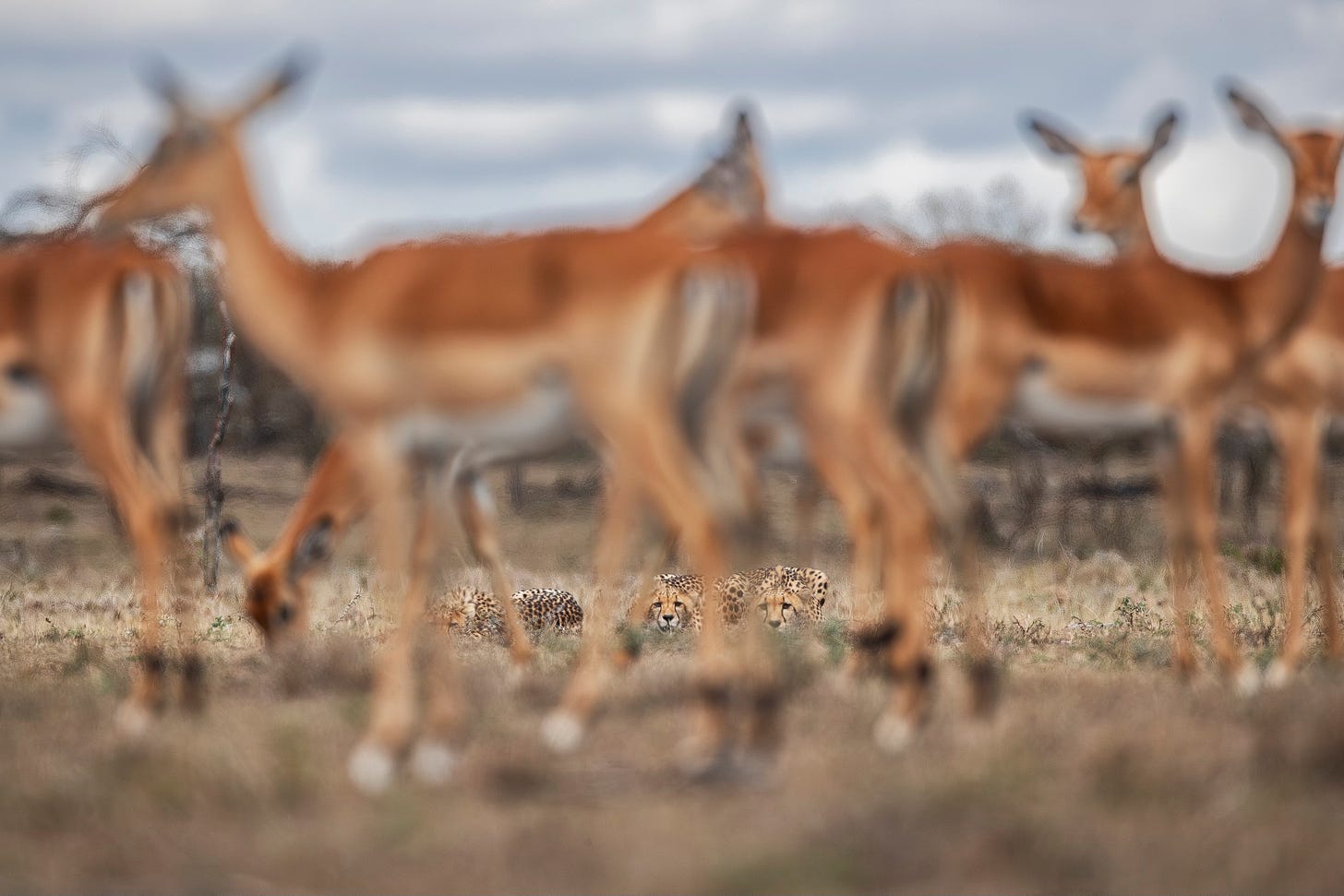


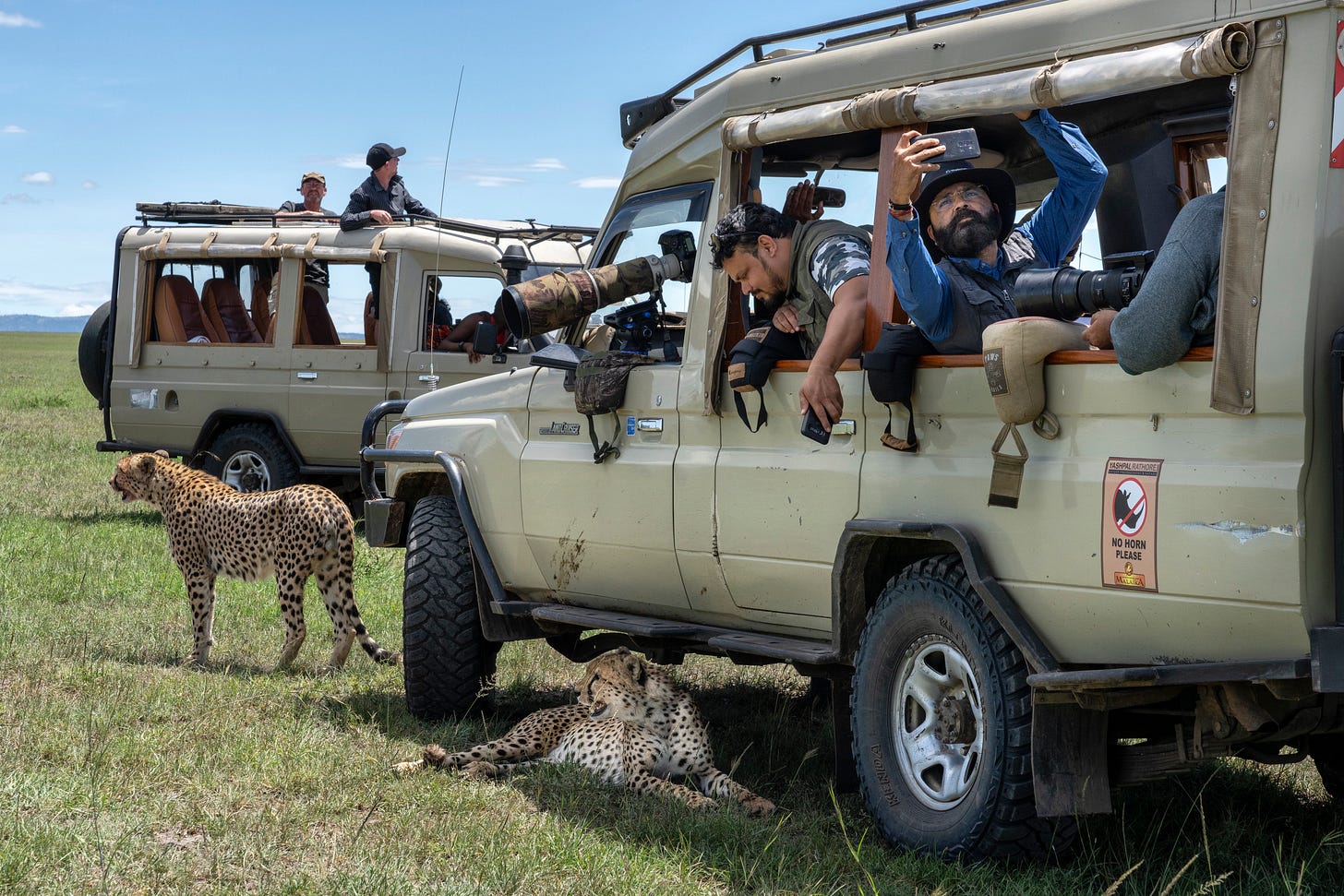
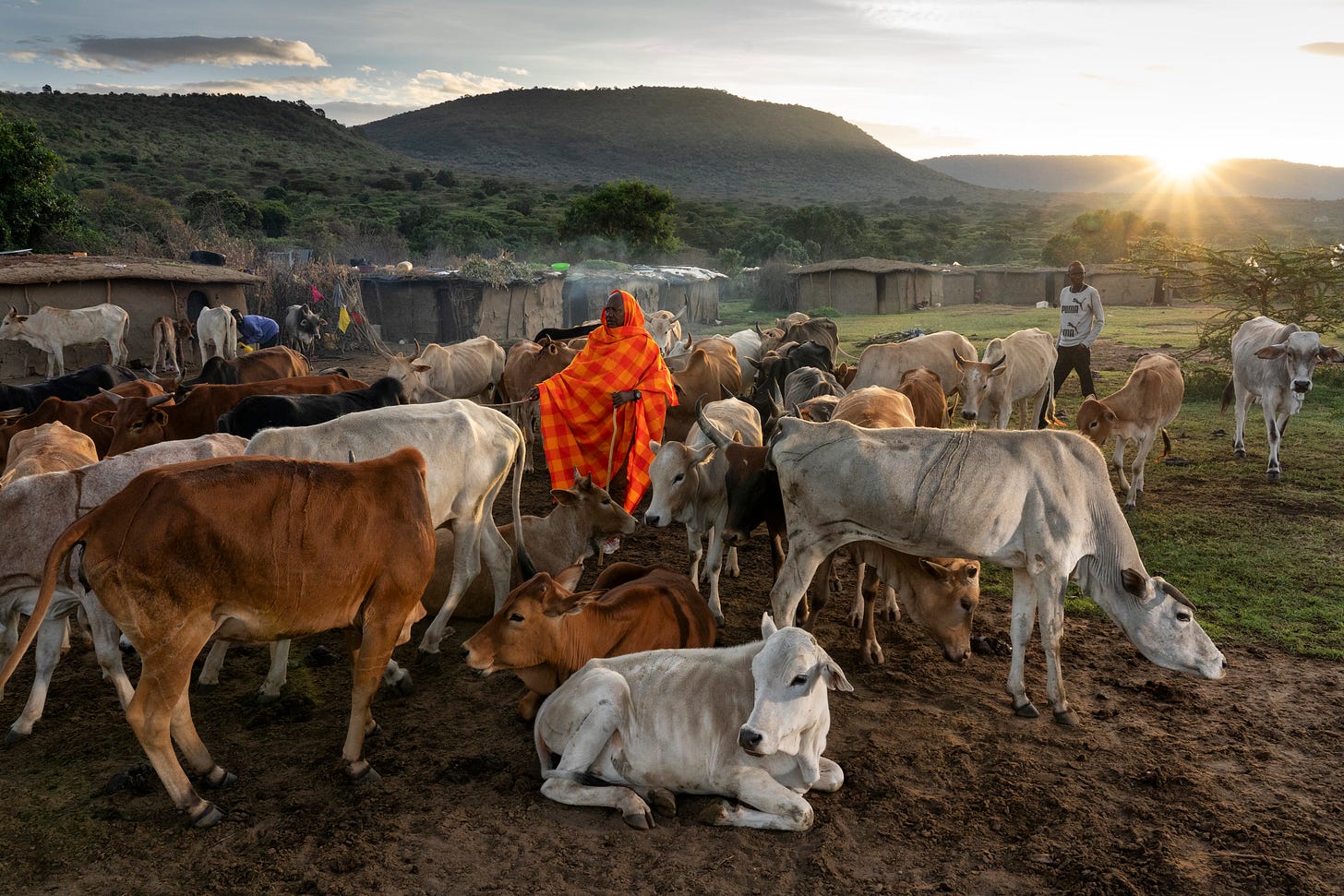
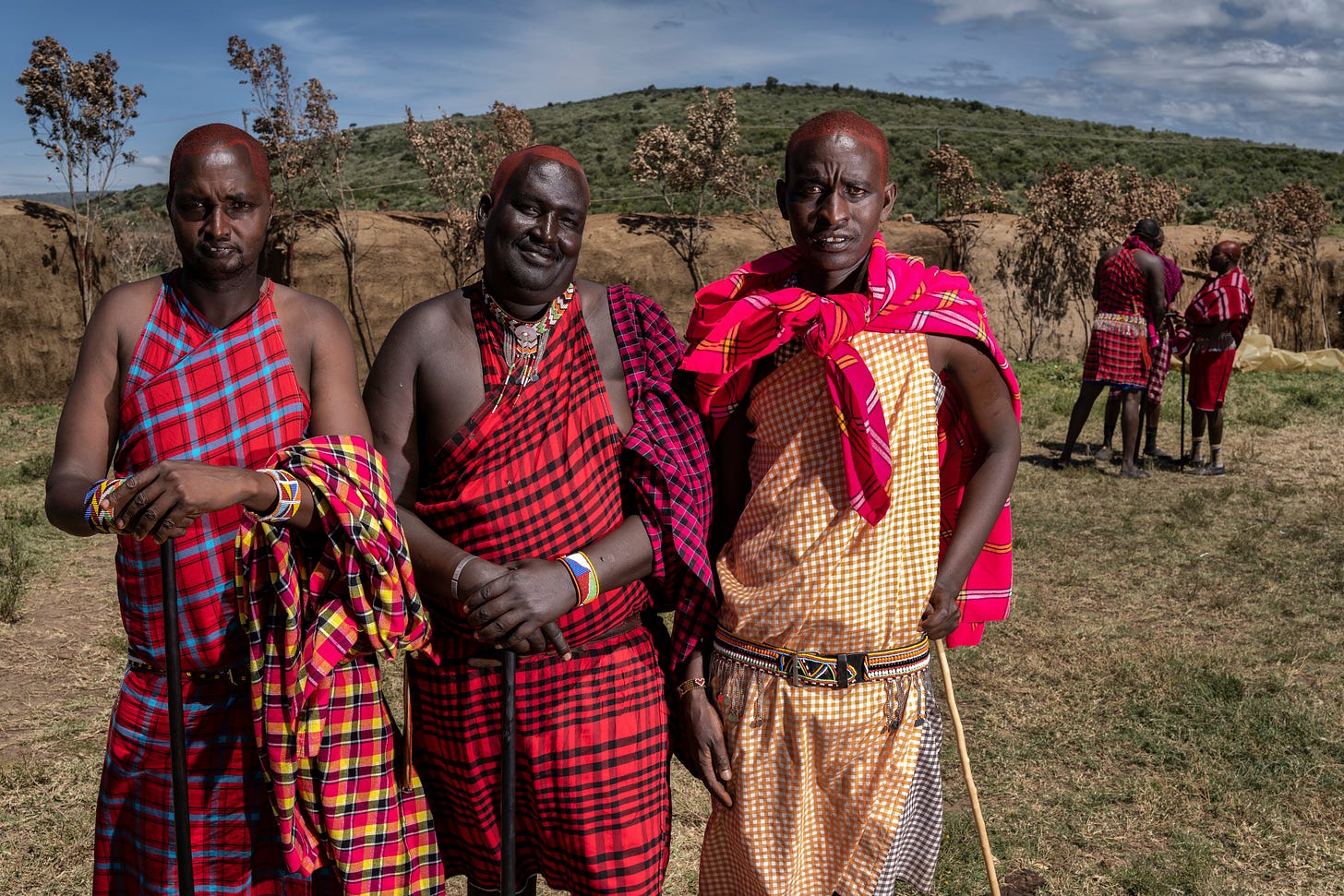

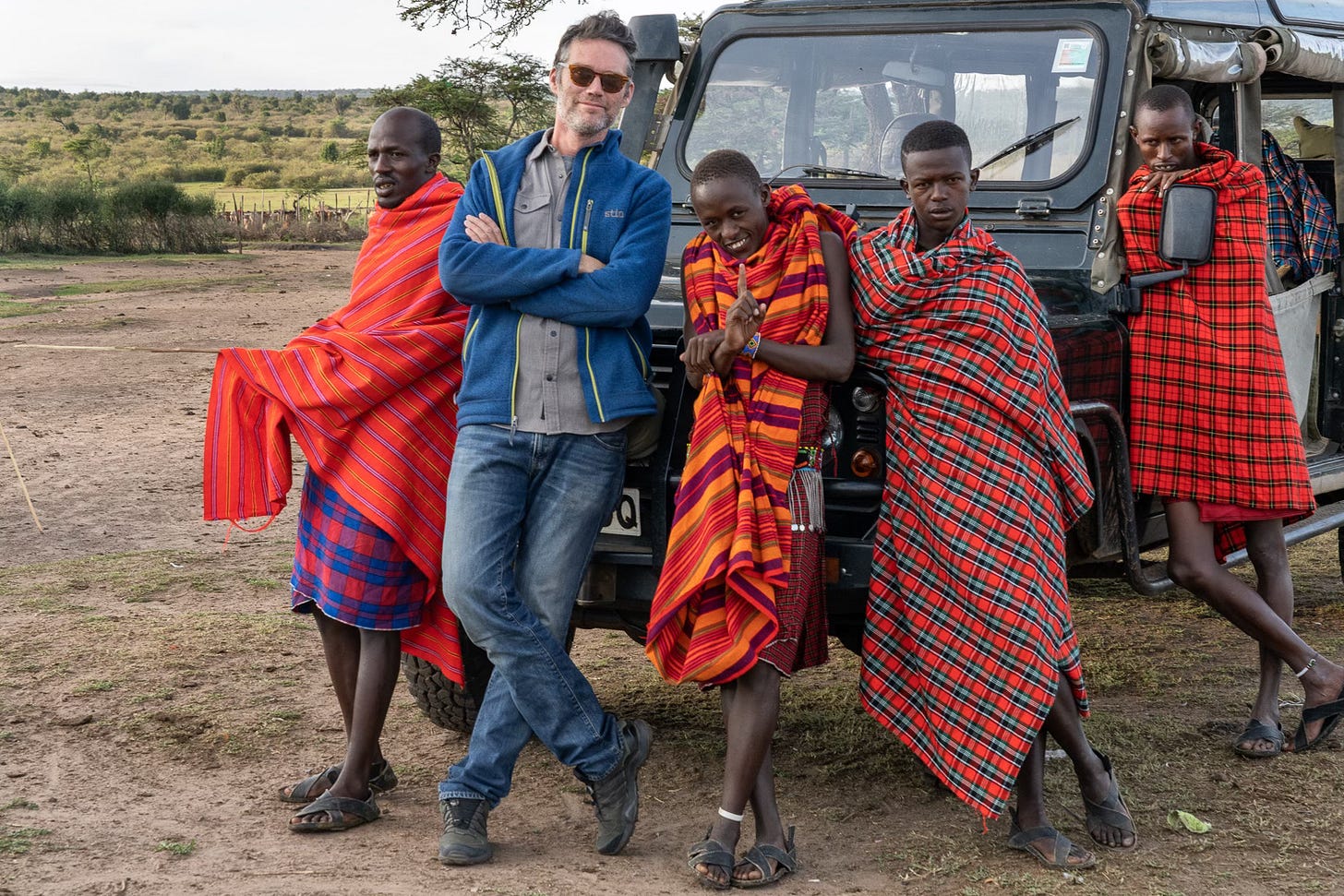
Which is why I never travelled to Africa. During lockdown I discovered a webcam in South Africa. It was focused on a dam, no commentary just bird sound, animal noises and weather. I spent hours watching this with a bird book and animal chart trying to work out my own identifications. I witnessed some amazing animal and bird behaviour. Perfect for someone now too old to travel.
A great read. I liked the contrast between the Maasai who enjoyed the photos that showed the reality, and the entitled tourists who didn't want the myth spoiled. Influencers have made travel even worse; I don't let these things keep me from seeing what I want to see. As a tourist, you can't separate yourself from it: all you can do is not be an entitled jerk about it. Thank you for sharing the ugly reality of things. It seems that many people live in a collective fantasy, like we are all stars of our own reality TV show, and showing the true face of it is important.